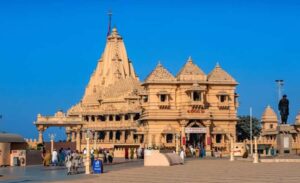Rishikesh: A Historical Journey
Rishikesh, a serene and spiritual town nestled in the northern Indian state of Uttarakhand, is renowned worldwide as the “Yoga Capital of the World” and a hub of spiritualism. It is situated in the foothills of the Himalayas, where the Ganges River flows through the region, making it an essential destination for pilgrims, yoga enthusiasts, and nature lovers alike. The history of Rishikesh is deeply intertwined with India’s rich cultural and religious heritage, and its evolution from ancient times to the present day is a fascinating journey.

Ancient Roots
Rishikesh’s history can be traced back to ancient times when it was known as “Kubjikā,” a name mentioned in the Skanda Purana, one of the eighteen Mahapuranas of Hinduism. The town’s existence in sacred texts and its proximity to the source of the Ganges River has made it a significant pilgrimage site for Hindus.
One of the most iconic landmarks of Rishikesh is the suspension bridge known as “Lakshman Jhula.” According to legend, Lord Rama’s brother, Lakshmana, is said to have crossed the Ganges on a jute rope at this very spot. In the early 19th century, a bridge was constructed at this location, which eventually led to the present-day Lakshman Jhula.
The Spiritual Hub
Rishikesh’s transformation into a spiritual center can be attributed to the presence of numerous ashrams and the legendary visit of Swami Vivekananda in 1893. Swami Vivekananda visited Rishikesh during his extensive travels across India and meditated on the banks of the Ganges. His stay at Rishikesh played a pivotal role in popularizing the town as a destination for spiritual seekers.
During the early 20th century, Rishikesh became a hub for various spiritual gurus and yogis, such as Paramahansa Yogananda and Swami Sivananda. They established ashrams in the area, offering teachings on yoga, meditation, and Vedanta philosophy. The Beatles’ visit to Rishikesh in 1968 to study Transcendental Meditation with Maharishi Mahesh Yogi further catapulted Rishikesh into the international spotlight.
The Influence of Yoga
Rishikesh’s association with yoga dates back centuries, but it gained global recognition in the mid-20th century. Yoga is an integral part of India’s cultural and spiritual heritage, and Rishikesh’s tranquil environment, with the backdrop of the Himalayas and the soothing flow of the Ganges, provided an ideal setting for the practice and propagation of yoga.
Swami Sivananda’s “Divine Life Society” ashram and his teachings on yoga and spirituality attracted practitioners from around the world. In the 1960s and 1970s, Rishikesh saw an influx of Westerners seeking spiritual enlightenment and yogic wisdom. The town’s reputation as the “Yoga Capital of the World” was solidified during this period.
Rishikesh’s Role in the Indian Independence Movement
The history of Rishikesh also bears witness to its participation in India’s struggle for independence from British colonial rule. Several freedom fighters and leaders, including Mahatma Gandhi, visited the town during their campaigns. Mahatma Gandhi, in particular, spent time at the Kailash Ashram in Rishikesh, where he delivered discourses and organized prayer meetings as part of the non-violent resistance movement against British oppression.
Natural Beauty and Adventure Tourism
Beyond its spiritual significance, Rishikesh offers stunning natural beauty and adventure tourism opportunities. The lush greenery of the surrounding forests, the towering peaks of the Himalayas, and the pristine waters of the Ganges River make Rishikesh a haven for nature enthusiasts and adventure seekers.
The region is known for its thrilling activities such as white-water rafting, trekking, camping, and wildlife exploration. The nearby Rajaji National Park, named after C. Rajagopalachari, the last Governor-General of India, is home to a diverse range of wildlife species, including elephants, tigers, leopards, and a variety of birds.
Modern Development
In recent decades, Rishikesh has witnessed significant infrastructural development to accommodate the growing influx of tourists. The construction of roads, bridges, and hotels has made the town more accessible to travelers from various parts of the world. While modern amenities have improved the convenience of visiting Rishikesh, efforts have been made to preserve its spiritual and cultural essence.
Festivals and Traditions
Rishikesh hosts several festivals and cultural events throughout the year. One of the most significant celebrations is the Ganga Aarti, which takes place at Triveni Ghat. During this ritual, priests offer prayers to the Ganges River, accompanied by chanting and the lighting of lamps. The atmosphere is charged with spiritual fervor, attracting both pilgrims and tourists alike.
Another important festival is the International Yoga Festival, which draws yoga practitioners, gurus, and enthusiasts from across the globe. It offers a platform for learning, practicing, and celebrating yoga in its various forms.
Conclusion
Rishikesh’s history is a captivating narrative of spiritual evolution, cultural significance, and natural beauty. From its ancient roots in Hindu mythology to its role in the Indian independence movement and its modern status as the “Yoga Capital of the World,” Rishikesh has continually evolved while preserving its spiritual essence.
Today, Rishikesh stands as a symbol of India’s rich heritage and a testament to the enduring appeal of yoga and spirituality. It welcomes seekers from all corners of the world, providing them with a serene and inspiring environment to explore their inner selves and connect with the profound spirituality that has defined this town for millennia. Rishikesh remains a timeless destination where history, culture, and nature converge in perfect harmony, offering a unique and enriching experience to all who visit.
Also Read





